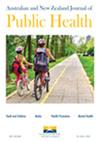Increasing awareness of sexually transmitted infections (STI) testing and addressing stigma may improve STI testing in Aboriginal and Torres Strait Islander youth: Evidence from the Next Generation Youth Wellbeing Study
IF 2.4
3区 医学
Q2 PUBLIC, ENVIRONMENTAL & OCCUPATIONAL HEALTH
Australian and New Zealand Journal of Public Health
Pub Date : 2024-11-16
DOI:10.1016/j.anzjph.2024.100203
引用次数: 0
Abstract
Objective
To quantify the prevalence of sexually transmitted infections (STI) testing in relation to sociodemographic, behavioural, and health related factors, and patterns in sexual health service (SHS) use and non-use among Aboriginal and Torres Strait Islander (hereafter Aboriginal) youth.
Methods
The analyses included N=198 sexually active 16-24-year-olds from Central Australia, Western Australia, and New South Wales participating in the Next Generation Youth Wellbeing Study. Modified Poisson regression estimated age-sex-adjusted prevalence ratios (PRs) for ever testing for STIs.
Results
Approximately 55% of the participants ever tested for STIs. Over 44% of the participants ever accessed SHS; perceived irrelevance (50%) and embarrassment (15%) were the main reasons for not accessing SHS. STI testing was higher among: 21–24-year-olds (68.75% vs 37.04% among 16–17-year-olds, PR: 1.82; confidence interval 1.23–2.67); those with high/very-high psychological distress (63.39% vs 44.55% among low/moderate group, 1.50;1.16–1.94); and those who lived in ≥3 houses in the past five years (65.43% vs 48.11% among those who lived in 1–2 houses, 1.33;1.04–1.70).
Conclusions
STI testing should be offered to sexually active Aboriginal youth at every opportunity.
Implications for public health
Sexual health messages should further promote the benefit of regular STI testing and where to access free SHS among Aboriginal youth.
提高原住民和托雷斯海峡岛民青少年对性传播感染(STI)检测的认识并消除耻辱感,可以改善性传播感染检测:下一代青年福祉研究》(Next Generation Youth Wellbeing Study)提供的证据。
目的量化原住民和托雷斯海峡岛民(以下简称 "原住民")青少年性传播感染(STI)检测率与社会人口、行为和健康相关因素的关系,以及使用和不使用性健康服务(SHS)的模式:分析对象包括澳大利亚中部、西澳大利亚州和新南威尔士州参加 "下一代青年福祉研究 "的 16-24 岁性生活活跃的 198 名青少年。修正的泊松回归估算了曾经接受性传播感染检测的年龄-性别调整流行率(PRs):结果:约 55% 的参与者曾接受过性传播感染检测。超过 44% 的受试者曾经接受过卫生和保健服务;认为无关紧要(50%)和尴尬(15%)是不接受卫生和保健服务的主要原因。以下人群的性传播感染检测率较高:21-24 岁人群(68.75% 对 16-17 岁人群中的 37.04%,PR:1.82;置信区间 1.23-2.67);有高度/极高度心理困扰人群(63.39% 对低度/中度人群中的 44.55%,1.50;1.16-1.94);以及过去五年中居住过≥3 套住房的人群(65.43% 对居住过 1-2 套住房人群中的 48.11%,1.33;1.04-1.70):结论:应利用一切机会为性行为活跃的原住民青年提供性传播感染检测:性健康信息应进一步向原住民青年宣传定期进行性传播感染检测的益处,以及在哪里可以获得免费的社会医疗服务。
本文章由计算机程序翻译,如有差异,请以英文原文为准。
求助全文
约1分钟内获得全文
求助全文
来源期刊

Australian and New Zealand Journal of Public Health
医学-公共卫生、环境卫生与职业卫生
CiteScore
4.20
自引率
5.70%
发文量
121
审稿时长
6-12 weeks
期刊介绍:
The Australian and New Zealand Journal of Public Health (ANZJPH) is concerned with public health issues. The research reported includes formal epidemiological inquiries into the correlates and causes of diseases and health-related behaviour, analyses of public policy affecting health and disease, and detailed studies of the cultures and social structures within which health and illness exist. The Journal is multidisciplinary and aims to publish methodologically sound research from any of the academic disciplines that constitute public health.
 求助内容:
求助内容: 应助结果提醒方式:
应助结果提醒方式:


